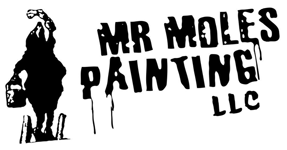People are visual creatures, and color plays a tremendous role in how we react and respond to things around us. When decorating your home, it’s important to understand how paint colors affect your mood. Just like the colors you wear, the colors of your rooms can affect how you and others feel in a space. Many psychologists believe there is a correlation between color and mood. When it’s time to paint your home, consider the primary function of the room and the mood you want to create.
Whether you want a cheerful and welcoming kitchen, a relaxing bedroom, or a productive home office, choosing the right paint colors is essential.
Follow These Tips When Selecting Interior Paint Colors
Colors are usually placed in two categories: warm and cool tones. Warm paint tones like red, orange, and yellow can energize a room. Cool paint tones such as blue, green, and purple encourage relaxation. Keep reading to learn more about how paint colors affect your mood.
Green
Green is a restful color, combining the refreshing quality of blue and the cheerfulness of yellow. Green hues can help clear the mind and reduce feelings of anxiety and stress. Green is considered restful and therapeutic. Green’s calming properties are why many schools, hospitals, and medical facilities use shades of green in their interior color schemes.
Blue
Blue is a calming color evoking feelings of water and sky. Blue shades can help lower blood pressure, clear the mind and help steady breathing. Light blue encourages relaxation and is a good choice for bedrooms.
Purple
Purple hues add a sense of luxury to any room. Lighter shades of purples such as lavender and lilac are calming and good choices for sleeping areas. Some think the best color for a home office is purple, which is thought to enhance creativity.
Red and Orange
Orange and red are warm colors that increase the sensation of warmth and heat. Red is associated with aggression, stimulation, and passion. Many restaurants use red and orange in their design schemes. Red is known to increase blood pressure, heart rate, and irritability, so it is not well suited for rooms meant for rest or relaxation. Orange is a happy, energetic color and a great choice for a home gym or children’s playroom.
Yellow
Yellow is a warm color associated with sunshine and happiness. Yellow increases energy and promotes creativity. Darker shades of yellow have been shown to cause tension in some people, especially babies, so opting for lighter shades of yellow is probably the best option.
Gray
Gray hues provide a crisp and refreshing atmosphere to a room that also adds comfort and warmth. Gray colors are believed to increase productivity and are frequently used in office spaces. Darker shades of gray are often perceived as drab or depressing, so lighter hues are best.
White
White gives rooms a feeling of cleanliness and freshness. Painting your ceilings white or off-white are easy options that go with just about every color and give the sense that the ceiling is higher and the room is more spacious.
Painting Different Spaces to Optimize Your Mood
To take advantage of color psychology, you should choose paint colors that match the primary purpose of each space or area in your home.
Bedrooms are a place for relaxation, so choosing light blues, soft greens, or light grays is a good idea. If you prefer a more dramatic color scheme, consider adding an accent wall in a darker shade.
Bathrooms are often considered a place to relax and unwind. Light blues and greens are good choices if a spa-like environment is your goal.
The colors you choose for a home office may vary depending on your work. Greens and light grays are good choices if productivity and focus are essential. If your job requires a lot of creativity, yellow or orange may be a better option.
If your living room is a place for relaxation, neutral colors like creamy whites, light grays, or beige are excellent choices. Earth tones have been shown to encourage conversation and are a good choice if you do a lot of entertaining in your living room.
White kitchens continue to be popular. White creates a sense of cleanliness and space. Warmer shades of yellow or light red are also good choices for kitchens.
Other Important Considerations
- How paint colors affect your mood and emotions varies widely among people. Your feelings about different colors are often deeply personal and rooted in your experience and culture.
- When choosing new paint colors for your home, there’s much to consider. The room’s lighting will significantly impact how a color looks. It’s essential to test large paint samples in a room to evaluate how natural and artificial lighting will affect the color.
- Color can be used to create or reduce the perception of space in a room. Painting a room white or light beige can make it seem more spacious, while darker colors create a cozier, more intimate feel.
- You may be tempted to DIY when it comes to interior painting. Although painting a small room on your own may be something you can handle, there are many times it makes more sense to hire a professional painting crew. Painting an entire home is a project that requires significant time, tools, and proper preparation.
Trust the Local Painting Professionals
The benefits of hiring a professional painter are numerous. You’ll save time, energy, and money. You’ll also have peace of mind knowing the work was done safely and professionally. By hiring local painting professionals, you’ll benefit from their expertise and support your local community at the same time.
Mr. Mole’s Painting LLC offers interior and exterior painting services for commercial and residential properties. We provide in-person and virtual quotes for your convenience. Contact us at (218) 368-2560 to discuss your next painting project. We look forward to working with you.
